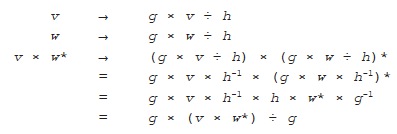
The quantity on the right hand side of the first equation, where we multiply the four components (
Any rotation of four-dimensional space can be achieved by fixing two vectors whose length is one, say

For example, a rotation that swaps North and South and also Future and Past, while leaving all directions orthogonal to these unchanged, can be achieved by setting
How can we be sure that this operation really is a rotation? For a start, it’s easy to see that the length of

We can also look at what happens to the angle between two vectors when we perform the same operation on both of them, by looking at the effect on

The Future component of
All rotations that involve only the three dimensions of space can be achieved by restricting the original formula to the case where

For example, rotating everything by half a turn in the horizontal (North-East) plane can be achieved by setting
Two other particular kinds of rotation occur when we set

and when we set

Both these operations will always rotate in two orthogonal planes simultaneously, and by exactly the same angle in both. For example, multiplying on the left by East will rotate by a quarter-turn in both the Future-East plane
Consider a rotation specified by

There are two other kinds of geometrical objects that can be described by quaternions, but which are

These curious objects are known as “spinors”:
Afterword
By the early years of the twentieth century, physicists had identified a variety of deeply puzzling phenomena—some naturally occurring, some the product of laboratory experiments—that could not be explained by the classical laws of mechanics, thermodynamics and electromagnetism. The spectrum of radiation emitted by an incandescently hot object made no sense: it should have contained an almost equal amount of energy at every possible frequency, but instead it tapered off rapidly as the frequency increased, a disparity known as the “ultraviolet catastrophe”. And while atoms had been shown to be composed of charged particles, both positive and negative, nobody could explain how they could be stable, or why the spectrum of hydrogen consisted of a set of sharply defined frequencies that followed a simple mathematical rule.
In the
Carla’s tarnished mirrors do have their closest match in one seminal experiment from the early days of quantum theory: the photoelectric effect. This phenomenon brought Nobel prizes in the 1920s to Albert Einstein for

